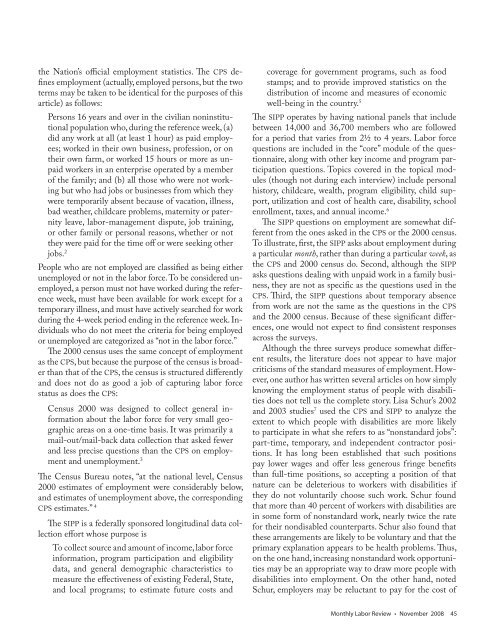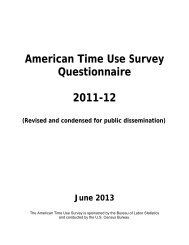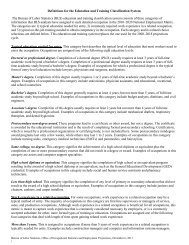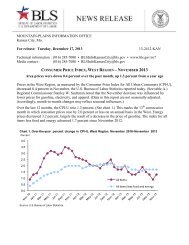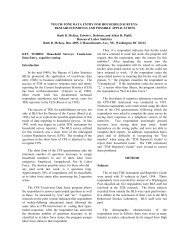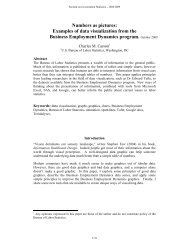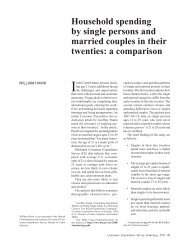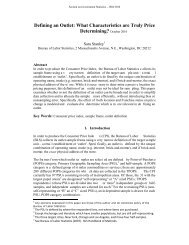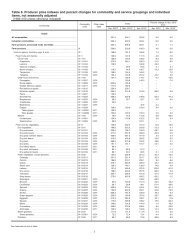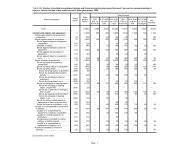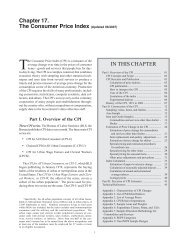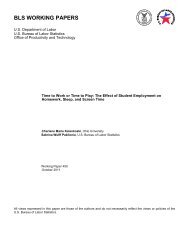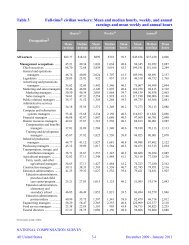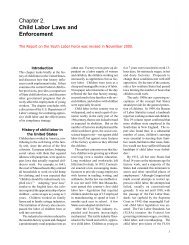The decline of employer stock as a 401(k) investment vehicle
The decline of employer stock as a 401(k) investment vehicle
The decline of employer stock as a 401(k) investment vehicle
Create successful ePaper yourself
Turn your PDF publications into a flip-book with our unique Google optimized e-Paper software.
the Nation’s <strong>of</strong>ficial employment statistics. <strong>The</strong> CPS defines<br />
employment (actually, employed persons, but the two<br />
terms may be taken to be identical for the purposes <strong>of</strong> this<br />
article) <strong>as</strong> follows:<br />
Persons 16 years and over in the civilian noninstitutional<br />
population who, during the reference week, (a)<br />
did any work at all (at le<strong>as</strong>t 1 hour) <strong>as</strong> paid employees;<br />
worked in their own business, pr<strong>of</strong>ession, or on<br />
their own farm, or worked 15 hours or more <strong>as</strong> unpaid<br />
workers in an enterprise operated by a member<br />
<strong>of</strong> the family; and (b) all those who were not working<br />
but who had jobs or businesses from which they<br />
were temporarily absent because <strong>of</strong> vacation, illness,<br />
bad weather, childcare problems, maternity or paternity<br />
leave, labor-management dispute, job training,<br />
or other family or personal re<strong>as</strong>ons, whether or not<br />
they were paid for the time <strong>of</strong>f or were seeking other<br />
jobs. 2<br />
People who are not employed are cl<strong>as</strong>sified <strong>as</strong> being either<br />
unemployed or not in the labor force. To be considered unemployed,<br />
a person must not have worked during the reference<br />
week, must have been available for work except for a<br />
temporary illness, and must have actively searched for work<br />
during the 4-week period ending in the reference week. Individuals<br />
who do not meet the criteria for being employed<br />
or unemployed are categorized <strong>as</strong> “not in the labor force.”<br />
<strong>The</strong> 2000 census uses the same concept <strong>of</strong> employment<br />
<strong>as</strong> the CPS, but because the purpose <strong>of</strong> the census is broader<br />
than that <strong>of</strong> the CPS, the census is structured differently<br />
and does not do <strong>as</strong> good a job <strong>of</strong> capturing labor force<br />
status <strong>as</strong> does the CPS:<br />
Census 2000 w<strong>as</strong> designed to collect general information<br />
about the labor force for very small geographic<br />
are<strong>as</strong> on a one-time b<strong>as</strong>is. It w<strong>as</strong> primarily a<br />
mail-out/mail-back data collection that <strong>as</strong>ked fewer<br />
and less precise questions than the CPS on employment<br />
and unemployment. 3<br />
<strong>The</strong> Census Bureau notes, “at the national level, Census<br />
2000 estimates <strong>of</strong> employment were considerably below,<br />
and estimates <strong>of</strong> unemployment above, the corresponding<br />
CPS estimates.” 4<br />
<strong>The</strong> SIPP is a federally sponsored longitudinal data collection<br />
effort whose purpose is<br />
To collect source and amount <strong>of</strong> income, labor force<br />
information, program participation and eligibility<br />
data, and general demographic characteristics to<br />
me<strong>as</strong>ure the effectiveness <strong>of</strong> existing Federal, State,<br />
and local programs; to estimate future costs and<br />
coverage for government programs, such <strong>as</strong> food<br />
stamps; and to provide improved statistics on the<br />
distribution <strong>of</strong> income and me<strong>as</strong>ures <strong>of</strong> economic<br />
well-being in the country. 5<br />
<strong>The</strong> SIPP operates by having national panels that include<br />
between 14,000 and 36,700 members who are followed<br />
for a period that varies from 2½ to 4 years. Labor force<br />
questions are included in the “core” module <strong>of</strong> the questionnaire,<br />
along with other key income and program participation<br />
questions. Topics covered in the topical modules<br />
(though not during each interview) include personal<br />
history, childcare, wealth, program eligibility, child support,<br />
utilization and cost <strong>of</strong> health care, disability, school<br />
enrollment, taxes, and annual income. 6<br />
<strong>The</strong> SIPP questions on employment are somewhat different<br />
from the ones <strong>as</strong>ked in the CPS or the 2000 census.<br />
To illustrate, first, the SIPP <strong>as</strong>ks about employment during<br />
a particular month, rather than during a particular week, <strong>as</strong><br />
the CPS and 2000 census do. Second, although the SIPP<br />
<strong>as</strong>ks questions dealing with unpaid work in a family business,<br />
they are not <strong>as</strong> specific <strong>as</strong> the questions used in the<br />
CPS. Third, the SIPP questions about temporary absence<br />
from work are not the same <strong>as</strong> the questions in the CPS<br />
and the 2000 census. Because <strong>of</strong> these significant differences,<br />
one would not expect to find consistent responses<br />
across the surveys.<br />
Although the three surveys produce somewhat different<br />
results, the literature does not appear to have major<br />
criticisms <strong>of</strong> the standard me<strong>as</strong>ures <strong>of</strong> employment. However,<br />
one author h<strong>as</strong> written several articles on how simply<br />
knowing the employment status <strong>of</strong> people with disabilities<br />
does not tell us the complete story. Lisa Schur’s 2002<br />
and 2003 studies7 used the CPS and SIPP to analyze the<br />
extent to which people with disabilities are more likely<br />
to participate in what she refers to <strong>as</strong> “nonstandard jobs”:<br />
part-time, temporary, and independent contractor positions.<br />
It h<strong>as</strong> long been established that such positions<br />
pay lower wages and <strong>of</strong>fer less generous fringe benefits<br />
than full-time positions, so accepting a position <strong>of</strong> that<br />
nature can be deleterious to workers with disabilities if<br />
they do not voluntarily choose such work. Schur found<br />
that more than 40 percent <strong>of</strong> workers with disabilities are<br />
in some form <strong>of</strong> nonstandard work, nearly twice the rate<br />
for their nondisabled counterparts. Schur also found that<br />
these arrangements are likely to be voluntary and that the<br />
primary explanation appears to be health problems. Thus,<br />
on the one hand, incre<strong>as</strong>ing nonstandard work opportunities<br />
may be an appropriate way to draw more people with<br />
disabilities into employment. On the other hand, noted<br />
Schur, <strong>employer</strong>s may be reluctant to pay for the cost <strong>of</strong><br />
Monthly Labor Review • November 2008 45


